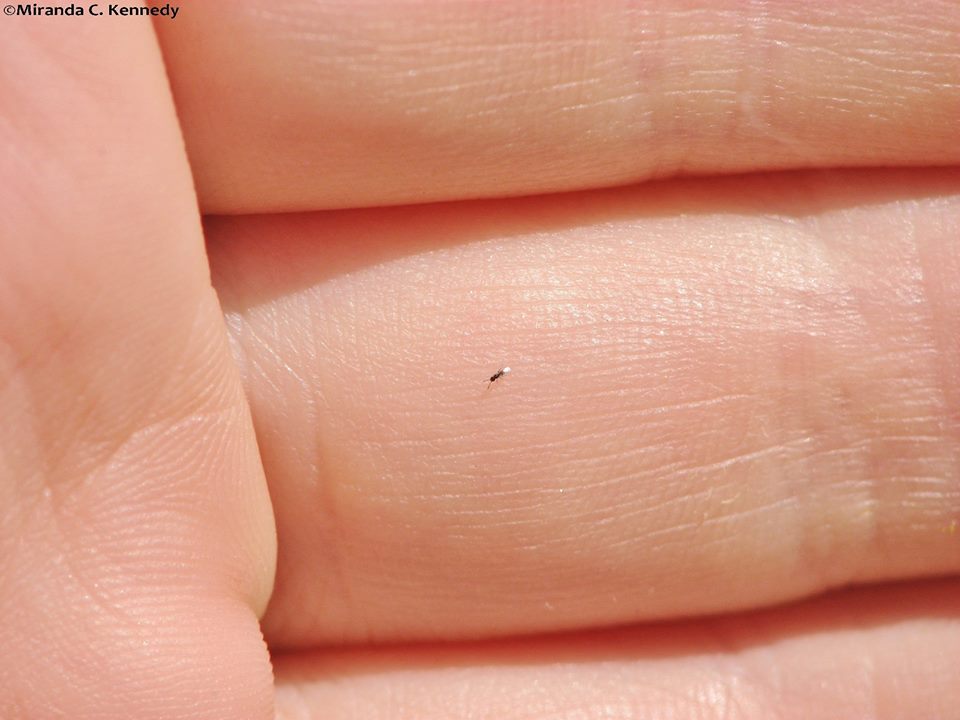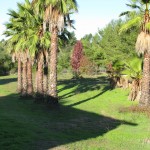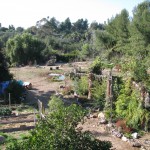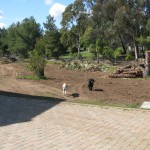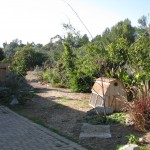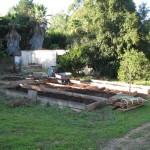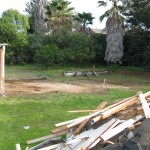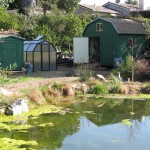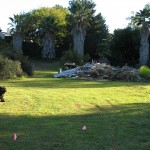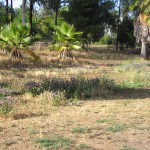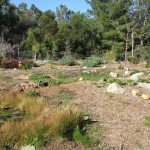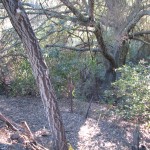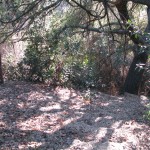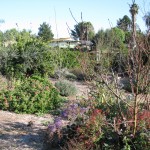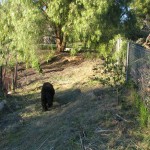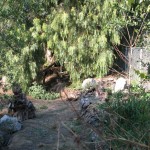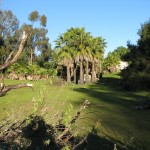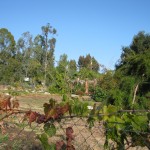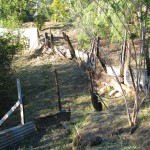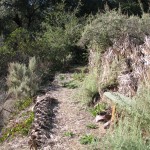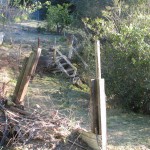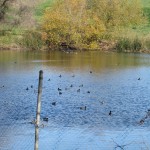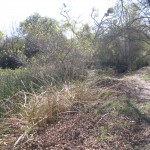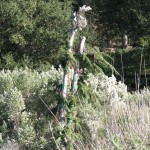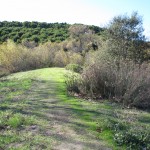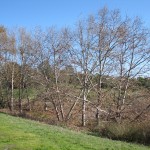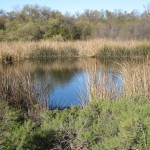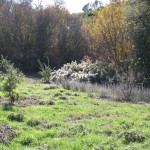Animals
-
Emerson and the Frizzle
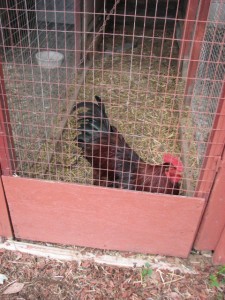
Emerson in Rooster Row Do you remember Emerson, the hen that turned into a rooster? (Read about it here: http://www.vegetariat.com/2011/07/segregating-rooster-building-bachelors-quarters-pvc/ ). To review, last year we chose several breeds of chicks, all of which were supposed to have been pullets (females, rather than cockerels). My daughter chose the smallest Rhode Island Red chick, knowing that she would grow to be one of the larger hens and not wanting her to be a bully. That adorable chick turned into Emerson, a huge, handsome rooster. And vicious. After growing up as a pet, as soon as his hormones kicked in he became a nasty attack rooster, flying up to try for our faces, hitting us with his wings (they really are strong and it hurts!), and practicing with his feet for when his spurs grew in. Since we didn’t want fertile eggs, Emerson lived a life of frustrated celibacy next to the girls. I’d asked around at feed stores if they wanted him, but no one did and they said they’d eat him or just kill him. Until a month ago when on a visit to the Vista Country Feed Store I asked again, and they wanted him! They had about thirty one-year-old Rhode Island Red hens they were going to throw him in with. Sorry ladies!
Getting Emerson out of his pen and into a dog carrier was hazardous and scary. My daughter used strawberry on a string as a lure, but darn him, he just wouldn’t step into the box. We tried for almost an hour. Then Jacob came to work on the ponds, and volunteered his services. He said he thought it would be fun! Using his jacket and sheer determination, he captured Emerson without injury to anyone. Amazing!
At the feed store a pen in a line of pens was made available for Emerson. He was temporarily in Rooster Alley. There was a Polish rooster, with the funny head feathers, and a couple of others, all of whom Emerson tried to challenge through the wire. Testosterone Central.
And then there was the frizzle rooster.
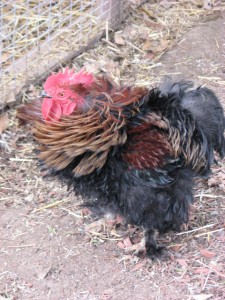
Mr. Frizzle and the Forward Feathers I saw the frizzle rooster there last year, after someone had dumped him there. He strutted around crowing and posturing, with his curly feathers and diminutive size. I fell in love. He was funny all over.

Mr. Frizzle Means Business. He Really Does. Everything he did was funny, although it was all rooster behaviour. Well this year he was still there, and apparently had been turned out of his pen for Emerson.
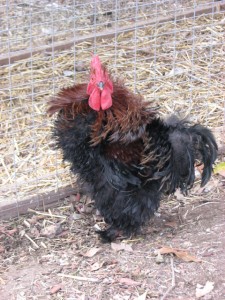
Mr. Frizzle Takes Time Out From Attacking Emerson To Pose For Video. That didn’t make him back down, though! That little guy challenged Emerson through the pen.
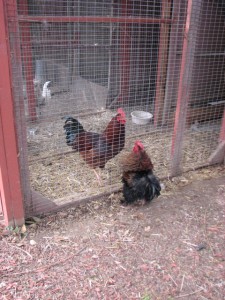
"If only this wire wasn't here I'd show YOU who is bigger!" What was truly hilarious was that after he’d crow, he’d breathe in air while still making sound, like a wheeze or a deflated bagpipes. Listen carefully on his last crow; you can see him (with Emerson) here: http://youtu.be/ivtpeHfOSDM . Thanks to my daughter for the video. Happy Days, Emerson! And much love Mr. Frizzle!
-
The Duck Boathouse

Mallards in the pond Our large pond has been attracting many waterbirds. We’ve seen mallards, widgeon, shovelers, snowy egrets, greater egrets, green heron, great blue heron, plus fishers such as phoebes and a kingfisher. In fact one mallard couple has become brave enough to waddle near when I feed the chickens. I throw a little scratch out, and the ducks snack on that along with the grasses. The male, who my daughter dubbed John Drake after the Secret Agent Man series main character, stands nearby and scolds me for not throwing out scratch on demand.
Since the garden plants are within their first year they haven’t grown in. I thought how great it would be to continue providing habitat by having a duck nesting box. I began to search online but the ones I saw were incredibly expensive for what amounts to just a box. You could place them on shore, but they would be within reach of predators. Or you could connect them to a pole sunk into the pond.
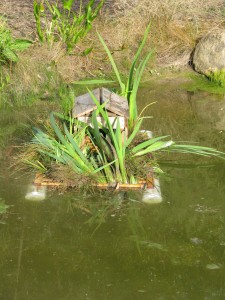
The front, with aquatic iris in front of the entrance. I broached Jacob with the subject and he was enthused, so he built one entirely out of scrap materials. I had a length of 4-inch PVC pipe with caps on the ends, which had come with the house. He used this as plastic pontoons for support. He tied on the side of a crib, built a little house out of a lightweight wooden crate I’d brought home that day which had transported potted plants, and dug up some of the plants already in the ponds to use as camouflage. The plants will live with their roots trailing in and helping clean the water. What came of all these recycled materials is just the cutest duck boathouse nesting box ever, I’m sure. I haven’t seen the female mallard for a few days, so she may be sitting on a nest elsewhere. I hope that a duck does enjoy the house, and if not, it is very fun to look at and is helping clean the water as it floats. What fun!

The back and sides, which will be hidden by plants as they grow. - Animals, Bees, Gardening adventures, Other Insects, Permaculture and Edible Forest Gardening Adventures
Catching My First Bee Swarm
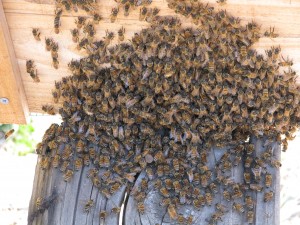 Today was warm but very windy, and I was stealing some time to work on trellises I’m building for the passionflower vines (another story for another time, and definitely for the humor section). The area I was working in was close to my house. Inside an enclosure for my trashcans there stands a stack of nine extra bee supers (or boxes). Last year a swarm moved in and I’ve let them stay since they were so happy (and had so much room!). I have a hive and two empty Top Bar hives down in my specially planted Bee Garden; why should a swarm go there when it can be near trashcans? So today I’m out there trying to unroll a roll of cattle wire without losing a finger, and I hear a loud buzzing. I looked up to see bees flying in ever widening circles around the trashcan enclosure. Normally they are in and out in a straight line (a honey flow) when gathering pollen. I wondered if they were being attacked or bothered by something because in my mind it is still early in the year. Then I remembered it is March already! The hive was swarming.
Today was warm but very windy, and I was stealing some time to work on trellises I’m building for the passionflower vines (another story for another time, and definitely for the humor section). The area I was working in was close to my house. Inside an enclosure for my trashcans there stands a stack of nine extra bee supers (or boxes). Last year a swarm moved in and I’ve let them stay since they were so happy (and had so much room!). I have a hive and two empty Top Bar hives down in my specially planted Bee Garden; why should a swarm go there when it can be near trashcans? So today I’m out there trying to unroll a roll of cattle wire without losing a finger, and I hear a loud buzzing. I looked up to see bees flying in ever widening circles around the trashcan enclosure. Normally they are in and out in a straight line (a honey flow) when gathering pollen. I wondered if they were being attacked or bothered by something because in my mind it is still early in the year. Then I remembered it is March already! The hive was swarming.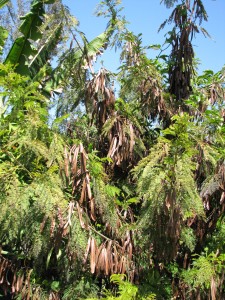
Can you see the swarm? Right in the middle. Just before a new queen hatches, the old queen takes a group of bees (depending upon the size of the hive, it could be 20,000 bees) to go find a new home. First they exit the hive and find a place to rest and reconnoiter. This is when people see them hanging from trees, underhangs, trashcans, whatever. Scouts are sent out to find a good place to stay. Sometimes they will stay where they are, even if it isn’t a good idea, such as the underside of a palm frond which a swarm built comb on for a short time some years ago in my yard. This swarm mercifully gathered in a guaje tree just opposite the enclosure.
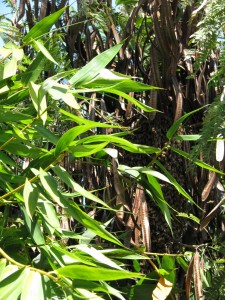
There they are. I let the wire go and realized how unprepared I was. I hadn’t completely finished preparing the bars for the top bar hives (so much to do!). My daughter and I have kept a hive for years. I really wanted that swarm, and although I’ve read about it and watched YouTube videos about it, just haven’t captured a wild swarm myself. I decided to try and get them.
First, I ran inside and rewatched a YouTube vlog on capturing a swarm, just to refresh my memory and boost my confidence. Then I ran down to the bee garden and prepared a top bar hive. I moved it to a better location, poured oil in the cups it sits in to keep out ants, and then finished preparing the bars. I’d serendipitously purchased craft sticks just yesterday ( a special stop at JoAnns), and I rubbed old wax into the grooves to make the craft sticks stick. Top bar hives have no foundation like Langstroth hives. The bees are encouraged to build their own comb, using the bit of craft stick hanging down from the bars as a guide. This is a healthier way to for bees to live when captured. Then I dropped a few drops of lemongrass oil into the hive; bees really like it and are attracted to it. I also smeared a little organic honey inside for some instant food. This sounds so smoothly done, but actually there were a dozen trips between the bee garden at the bottom of the property, the house, the shed and the swarm, all done in a crazed, frantic and nervous sort of way. A mad woman. Again I’m grateful for good neighbors.

Top bar hive, with craft sticks waxed onto the underside of a bar. I suited up in full bee gear. Many people catch swarms without protective gear, or with just a veil. When bees swarm they are the least likely to attack because they aren’t defending a hive. They are clustering around their queen, not wanting to be separated from her. However, since I now swell up dramatically when stung, I decided to take no chances.
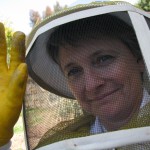
Hi. Fortunately the bees weren’t high up. I dragged out a stepladder and found a smallish cardboard box.
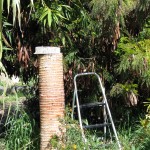
Fortunately within easy reach of a stepladder. Standing on the ladder and shoving the box under the swarm, I shook the branch, knocking the bees into the box. When I thought I had most of them, I carried the box, full of crawling bees, down to the hive. I wish I could have taken a photo, but with the thousands of bees in the box I didn’t want to go get the camera and fumble with it with my gloves; I didn’t want to hurt any of the girls and they needed to be relocated before they took flight. I shook the box into the open top of the hive, and then put the top bar lid on. There were still bees back on the tree. I didn’t see the queen, and I really needed to make sure I got her. I shook in the rest of the bees and then carried them back down to the bee garden.

I shook the cardboard box of bees onto the ramp. I didn’t want to open the hive again, so I propped a board up to the entrance holes, then shook the box of bees out onto the ramp. Bees will climb, and climb they did. I used a bee brush to carefully collect bees that had clung to the outsides of the hive, and dumped them on the ramp, too. There was quite a traffic jam for awhile.
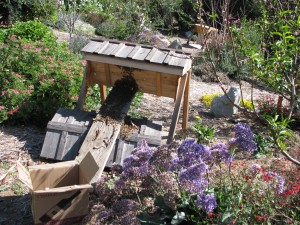
Traffic jam of bees climbing up the ramp into the opening. Eventually all the bees were in. I removed the ramp and cleaned up… not a sting. Actually, once I first climbed the stepladder I felt and heard the lack of anger in the swarm. They weren’t making a high-pitched angry buzzing noise. Tradition has it that you should talk to your bees; make sure to tell them about any change in the household. So I talked to them as I transported them down to what would hopefully be their new home. Just before dark I rapped once on the side of the hive and all 10- or 20-thousand of them hummed at me. If I got the queen and they are happy, then they will stay. Otherwise they’ll swarm again. No bees were harmed, and the few left up by the tree wondering where the old queen went were close enough to the old hive to go back, and make their allegiance to the new queen.

Almost all in. 
The girls are spraying pheromones to mark their location. I came inside feeling good about gently relocating them, and had some dark chocolate to settle my nerves! Then I went on to wrangle with the wire and the trellises, which was far more trouble than moving a swarm of bees.
- Birding, Chickens, Gardening adventures, Houses, Living structures, Permaculture and Edible Forest Gardening Adventures
Building a Withy Bird Hide
I was going to continue my series on weeding, but I’ll pick it up next post. Yesterday we received almost an inch of rain. Whoopee! It wasn’t the damaging downpour we had a few weeks ago, either. It was steady and soaking. The temperatures dipped but not to frost (what a strange February!). This morning after I sat clutching my warm tea mug and doing some Internet research, I went outside to check out the yard and it felt like the first day of spring. Cool but not cold. Wet but not soggy. Cloudy and a little threatening but with patches of sunlight. Birds going nuts in all the bushes and trees. It reminded me of our first trip to England during Easter week five years back. There was this feeling, both there and here today of movement everywhere. The soil was stirring with awakening seeds and slumbering creatures.
I put on a knit hat and old clothes and a jacket (ever the lady!) and was all set to pull weeds from the wet ground. Instead I felt inspired to create a bird hide. So, right now you’re thinking of places where birds can hold up. Actually I already have these; they are brush piles all around the fence just for the purpose of providing shelter and escape venues for critters. A bird hide is actually a structure where bird watchers may watch and photograph birds without being seen by them. We have mallards, wigeon and egrets coming to our pond, as well as plenty of songbirds in the surrounding trees. I wanted a bird hide for us and visitors in which to sit and watch.
Since I can’t build anything (the whole measurement thing… I’ve already told you about that) I obtained prices from Quality Sheds in Menifee who built my two sheds so well. Expensive… yep, but not as much as hiring a carpenter, even if he used scraps from my old sheds. Then this morning I started browsing the Internet (trying to stay by that warm teacup as long as possible) and researched withy structures, tree branch structures, living buildings…. all fascinating. Withy is a bendable piece of willow, and sometimes other wood. I’ve always wanted to make a living thing out of willow; stick pieces in the ground, weave together the shoots and it roots and grows! I’ve seen living willow benches before.
So I figured I’d seize the day, this beautiful unofficial start of spring, and see if I could make a decent hide. There are other wonderful structures on the property build by Roger Boddaert and crew, so something natural would not only fit in and be ecologically more sound (than having a structure built), I know the wonderful feeling of being in a structure that is made of natural materials.
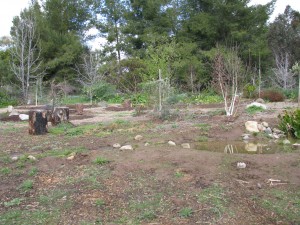
The spot. This spot was left untouched during the creation of the garden because somewhere in the area there had been a fairy ring, which is a ring of mushrooms growing out from a central fungus. I’ve given up hope that its still alive, and this is an ideal spot for watching birds both in the pond and in the trees behind.
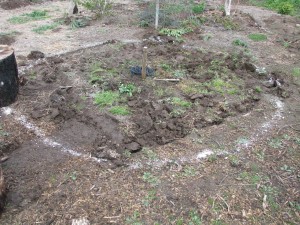
A ten-foot circle. I guessed where the center was, measured roughly five feet (I stepped on the string and held it to my head… I’m 5’3″) and made a ten-foot circle. Why ten? Eight looked too small and twelve too large. I also uncovered the irrigation lines so that I could avoid breaking them (only one casualty).

These logs have to go over there. Old burnt tree stumps had been given to me by Juan, who constructed most of the garden. They’ve been happily growing fungus and providing some habitat as they’ve sat waiting for me to figure out what to do with them. Of course, I wait for the day after a heavy rain when they are good and soaked to move them, and uphill at that! Most of them were old and light enough to roll without too much effort.
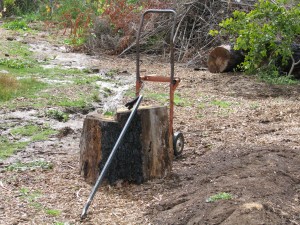
This didn't work. I ended up walking it. Then there was this squat, misshapen devil. It was just oddly shaped enough to not roll, too short and heavy to move with the dolly. Finally I just walked it, bit by bit, curse by curse. I laughed like a madwoman when I put it in place. I’m really glad that I have tolerant neighbors. I often tell my chiropractor about my garden projects. He seems to really like them, and encourages me to keep on hauling flagstone, rolling logs, etc. Hmm.
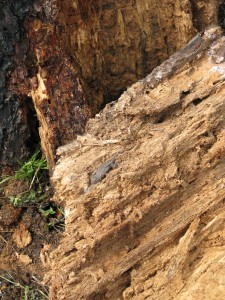
Besides growing interesting fungus, a sleepy lizard was hiding in the log. Of course, right as I position it, some of the back breaks off. There was a sleepy Western fence lizard trying to keep warm.
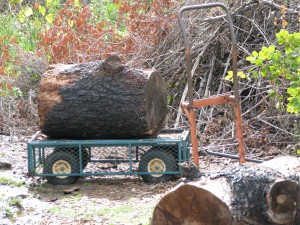
With some interesting swearing, I tipped it onto my wonderful wagon. Just when I thought I’d moved the heaviest, the last one proved to be a monster. It wouldn’t roll. It wouldn’t wheel. I brought out my incredibly handy garden cart, tipped it up, hoisted that guy onto it and off we went! It wasn’t that easy, but I did it. I had a feeling of satisfaction and accomplishment similar to when I took Tai Kwon Do with my kids, and broke a board with my hand and one with my foot. I felt as if I could chop down walls! Anyway, making this ring felt right, and perhaps their acid decomposition will inspire another mushroom ring.

If Stonehenge caught fire. Then I scavenged for old twisty branches and willow. Although I have native willow growing in the streambed, I opted for curly willow for the sides. Not only is it more architecturally pleasing to my eye, it likes full sun and is more drought tolerant than other willows.
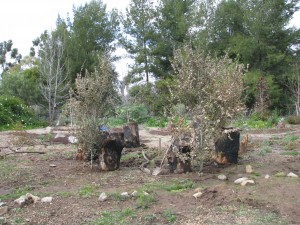
Cut oak trees stuck in for camoflage. Since the willows would just be whips yet, I wanted to kick-start the hide with some camouflage in the form of dead oak trees that hadn’t yet shed their leaves. I stuck them in the mud on either side of the main viewing window. They can be incorporated into the design as the willows grow, or come out easily. Everything is reversible! (I try not to build anything that isn’t).
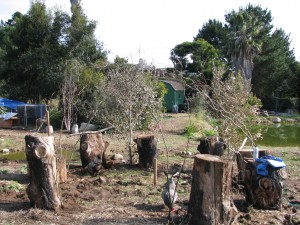
The girls helping me plant the willow withys. I managed to find some long curly willow off of the plants that aren’t even a year old in my garden yet. I want the withys to meet overhead. The ‘windows’ will be over the stumps, except for the main window looking down to the pond. The hens came over to help plant willow by standing on the shovel and in the hole slurping valuable worms. I sure loved the company.
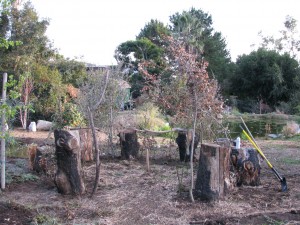
From the entrance. I planted all the willow, but didn’t really finish working on the upper portion before sunset. I really wanted to finish, too, and move on to weeding. Giving the project a little time will help me in finishing it, especially since I’m making it up as I go! I’m not weaving the structure like many willow structures are, but I will be shaping them so that they grow in the right way.

As it looks to ducks. A little anticlimactic, but I’m not done yet! The willow will be growing and filling out with leaves, making the roof canopy all in good time. I bet there are ducks in the pond right now not paying any attention to the hide! 🙂 Tomorrow I might look at it , recoil in horror, and pull everything out. Or not. I’ll let you know.
-
Monday Morning Surfing
Okay, so its Monday morning at ten o’clock and I’m trying to make an unsweetened cup of tea stretch out as an excuse to read funny stuff on the Internet. That’s one of the benefits of living alone… no one but the little taskmaster in my head to crack the whip. Oh, and the bank, but its President’s Day so they should all be closed. Oh, and the animals, but I’ve fed them all, with the exception of Gammera (“Feed the tortoise today, Diane! Remember to feed the tortoise!”). The unsweetened tea is a kind of torture because I usually take it with honey, but I am trying really, really hard to lose that twenty pounds that I thought I had lost for good a couple of years ago, but which found me again. I’m also using the excuse that its the Great Backyard Bird Count weekend to watch the birds swarming to the feeders as I surf. All of this, of course, is an excuse to not go dig bamboo and transplant enormously heavy trees like I did yesterday (that ingrate of a lemon tree poked me in the eye while I was trying to rescue it! I left that sucker partially dug out last night as punishment. See if it learned its lesson by now…). Oh, and its a little cool outside (what a California wimp I am!). I am also feeling the afterguilt (new word?) from having ranted on the blog yesterday. Besides, funny things happen.
For instance last night, while I was watching a couple of Rowen and Martin’s Laugh-In episodes I had waited forever for the library to get in (and can’t renew because its on hold), my fat cat Pippin was zonked out on my favorite chair. Pippin is about 18 pounds. He was a skinny boy that showed up in our yard a couple of years ago and never went away. He sucked down food as if he needed it for emotional support (um… that sounds familiar!). Only one of my other indoor cats will tolerate him. Matthew is a kind-hearted soul. He’s a peace and love kind of cat, at least he’s become that after spending his first year of being in the house hiding behind the bookcase hissing at everyone. Matthew has a deep throaty whirr when he plays wildly with cat toys. Anyway, Matthew, in search of a warm spot (I don’t turn on the house heat), perched on top of the lovely ribbon-embroidery pillow next to Pippin. Somewhere around the point in Laugh In when Miss Greer Garson hit Henry Gibson on the head with an inflated hammer I glanced over to the chair (myself wrapped in several blankets, a robe and two cats), and saw that Matthew had found a warmer place to perch!

A warm, firm mattress that purrs! Pippin is solid, like a beached whale. He protested a little by waving his paw ineffectually (his front legs stick out straight when he lays on his side) and then going back to sleep.

When Pippin moved, Matthew... didn't. So my Internet search started with Facebook, to see if there were any humorous links from my more sophisticated friends (I’m always at least a year behind in finding out the funny stuff. At least three years behind in technology!). Then I checked out Cake Wrecks ( http://cakewrecks.squarespace.com/ ) , which is a hilariously funny blog that posts disaster cakes with wonderful commentary. From there I went to The Bloggess (http://thebloggess.com/2012/02/her-name-is-juanita-juanita-weasel-unless-you-can-think-of-something-better/ ). This blog has pretty ‘mature’ language and topics, but it is laugh-till-you-choke hilarious. From there I went to Know Your Meme (http://knowyourmeme.com/ ). A meme (rhymes with cream… I looked it up) is whatever has viral popularity on the Internet. This site lists current memes, some of which are actually funny, but most of which make you really wonder about the average intelligence of the US Internet audience. Then I followed her link to Pintrest (http://pinterest.com/thebloggess/kick-ass-stuff/) which is a virtual bulletin board where people ‘pin’ interesting things they find on the Internet. Think of it like a workroom pinboard with cut-out jokes and photos hung all over it. I swear, I don’t know how people find the time to do all this Internet stuff and yet conduct normal lives or get enough exercise.
Speaking of exercise, I need to go see if that lemon tree has learned its lesson yet. Oh, and feed the tortoise.
- Animals, Bees, Birding, Chickens, Gardening adventures, Heirloom Plants, Other Insects, Permaculture and Edible Forest Gardening Adventures, Photos, Ponds, Rain Catching, Vegan, Vegetables, Vegetarian
Garden’s One Year Anniversary
Happy Anniversary! One year ago on Feb. 1, 2011, I signed a contract with landscape architect Roger Boddaert (760-728-4297) to create a permaculture garden. For twelve years I’ve had this sloping property that was covered in weeds and worthless Washingtonia palms. Not only do these 2 acres slope down to a barranca, but it was filled in due to catching all the rainwater that runs from the street and properties above. I have to give credit to friend Gary B., who brought up the subject of permaculture in a conversation the year before. I’d heard the term and thought I knew what it was about, but months later when I was researching what to do with my property I remembered him mentioning it, and looked it up. I found what I was looking for. I’ve been an organic gardener for many years, have owned chickens for their eggs, have refused to till the soil so as not to kill microbes, have worked naturally with animals and plants, have created habitat, composted, recycled, collected rainwater… and all of that was permaculture. And so much more. How can one not be attracted to the term Food Forest? Certainly not a foodie and gardener like myself.
What happened on the property starting the week of Feb. 1 for the next six months altered the land so that it is truly two acres of habitat. It is useful, it is natural, and it is beautiful. Roger’s team led by Juan built beautiful walls of urbanite, planted and hauled, worked in scorching sun and frosty mornings and made what was dreamed into reality. An integral part of the garden has been diverting the water from erosion points and into rain catchment basins and natural ponds, and that is where Aart DeVos and Jacob Hatch of Aquascape (760-917-7457) came in. They also installed the irrigation. Dan Barnes did the rough and the precise tractor work (760-731-0985) and I can’t recommend his experience and skill enough. Fain Drilling dug the well (760-522-7419) and the wonderful sheds were built by Quality Sheds of Menifee (http://www.socalsheds.com) .
Along with some volunteer help from Jacob, I am the sole caretaker of the property. I am planning the plant guilds, weeding, improving soil, moving problem plants and trees and, did I mention, weed? Oh yes, then there is weeding. On Saturday May 12th, the garden will be on the Garden Tour of the Association of University Women of Fallbrook, and hopefully many people will be inspired to go organic, to create habitat, conserve water and grow extra food for the Fallbrook Food Pantry. We’ve come a long way, baby!
The following photos are comparisons between the precise location last year at this time, and today.
The property last February. The property today. Sophie and General loved all the excitement. They love the new gardens and pond even more. My veggie beds with the old sheds behind. My veggie beds with the new sheds and greenhouse behind. Where the big sheds were: everything usable was reused. New sheds that aren’t a safety hazard, and the greenhouse. The lower area with shed debris (lots of mowing area!). Hey, there are ponds there now! Not much for the neighbors to look at. Quite a lot for the neighbors to look at! Access to the old oak was hazardous. Palm stairs lead past the oak to a birding area. Stonefruit were old when I moved in. New stonefruit adorn what is now the Bee Garden. An erosion area sloping down to the barranca. Water won’t flow through here anymore. Lots of mowing and palm frond removal. Not so anymore. Horrible looking debris failed to hold back the embankment. Palms were used to stabilize the new paths and camoflage the supports. Old unstable stairs led to washout areas. New railings, stairs and urbanite retaining walls lead to another viewing area. The view from my balcony. Part of the old shed remains. Hey, there’s a pond there! -
A New-Fangled Coop

The new coop I’ve been trying to find a warmer coop for my hens. The chicken tractor that they occupy is not only non-mobile, but is open on all sides with only scant shelter in the nesting ledge. This won’t do. I have tarps draped all over it, and raise and lower them with the sun to keep my girls from being in the wind. It isn’t perfect. Not being a carpenter, I have to search for what I want, and I’ve been searching for coops so much on the Internet that for awhile almost every ad that popped up was for coops! Most coops come unassembled, and not only are extremely pricey but look very thin-walled. Last Saturday over breakfast (of eggs, of course) I tried Craigslist. There were several used coops for sale, but not only would I have to disassemble and reassemble them, but the possibility of transferring disease or bugs was high. Then there appeared a new ad for coops in Temecula, just half and hour away from me! The Knotty Bird (https://sites.google.com/site/theknottybirdcompany/contact-us) is a home business of Crystal Braught. She and her husband create the coops in their home, and house their own flock of lovelies in the backyard. The three styles of coops that were offered were very well thought-out, and I loved the strawberry pyramid that was also offered. I had a wonderful talk with Crystal, who grows organic veg and recommended to me a most excellent seed source, Baker Creek Heirloom Seeds (http://rareseeds.com/) which not only offers hundreds of seeds from around the world, but sells only organic seed.

Access to the nestboxes, a small entrance, and the far bottom side lifts up for cleaning or expansion. So I bought the middle-sized coop at a very reasonable price and hauled it home. (This all sounds so easy! But not for me! I wanted to use my son’s truck, but the insurance and registration had been let go. I spent awhile on the phone adding the truck to my insurance, and then trying in vain to register it on the DMV site. Then halfway there on the freeway the brakes began to grind and it sounded as if metal was dragging on the tire. I pulled off and looked, but didn’t discover anything. When I arrived safely (whew) home with the coop, I had to unload it alone so I propped up a planter, some wood, a piece of plywood I had to haul up from the bottom of the property, and then slowly walk the bottomless coop out of the truck and slowly down the plywood without destroying it or me. It weighs over 100 lbs. I haven’t lost my touch; all safe and sound).

I put newspaper-lined nursery flats under the roost, which turned out to be a bad move. I placed a couple of nursery flats lined with paper under their new roost upstairs for easy clean-up, and fluffed straw into the two small nestboxes. The coop I walked until it was over tall grass that I wanted gone. Then I brought the three girls up, one by one. They loved it. They scratched and tore off pieces of grass and had a grand time. At dusk, though, they stood there looking at me. Finally Chickpea went up the ramp into the living quarters. With some encouragement and direction from me, Miss Amelia and Lark finally went up there too. I still partially covered the coop with a blanket because it was going to be a cold and possibly windy night. Emerson, in his lonely cage at the lower end of the property, was quite the sad guy.

The roof on one side can be propped open for cleaning. In the morning I fed the dogs outside and noticed that the girls hadn’t come downstairs. I waited and later went out and they still weren’t! I opened the side to peek, and found that they had moved one of the lined nursery flats over the exit hole! Poor girls! I moved it and they eagerly came down, but weren’ that interested in the grass anymore. I thought maybe they’d eaten too much the day before. They stood and watched me work. Very eerie.

The three girls enjoying the grass I tried to encourage them back up the ramp to the nesting boxes, but they would have none of it. Finally, exasperated, I opened the door and they scuttled down the hill and it was an easy thing to shoo them into their old cold coop. Chickpea went right up the ramp to lay an egg. My poor girls! The coop may not work for these girls, but now I have a seperate place for the Frizzles I want to get come spring! And instead of one large coop with a lot of pecking and competition, I can have several small coops placed around the property, each being a chicken tractor while the girls scratch up the grass and feed the soil.
Apparently,
-
Salton Sea

Salton Sea is a terminal sea; there is no connection to any other water Salton Sea is a terminal sea, created by accident in 1905 by a break in an irrigation canal from the Colorado River.

Trains a hundred cars long pass by regularly Salty and as it evaporates, becoming saltier, the sea hosts water sports, camping, and in the summer black flies by the millions, temperatures well over 100F, and the smell of rotting fish. However it is also one of the birding hotspots of the United States, as it is located along the Pacific Flyway in the Imperial Valley.

Black-necked stilt My daughter and I took advantage of the cooler post-Christmas weather and drove there last week. Winter is the best time to see birds and we weren’t disappointed.

Great egrets rest in the trees by the Visitor's Center The drive was a little over two and a half hours from our home, skirting the mountains and into the desert communities.The Sea is about 35 miles long, and is about 227 feet below sea level. The north-west part of Salton Sea hosts the visitor’s center and some good birding areas, but the best areas for us were about thirty miles south (it isn’t called a sea for nothing!) at the Sonny Bono Salton Sea National Wildlife Refuge, Unit #1.

Pelagic birds dining at Sonny Bono Fish die-off is a sad part of the life cycle of the mineral-heavy sea, and the sand is layered with the decomposing bones of millions of fish.
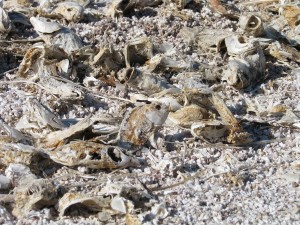
The sand is made of disintigrating fish bones Thousands of birds in enormous flocks can be seen all around the Sea. It is a grand thing to witness; it had been a common sight until fairly recently in US history to have flocks of birds so dense they blacken the sky.

Catching afternoon sunshine between feedings There weren’t that many there, but the numbers were amazing. In the southern part are agricultural fields where we saw hundreds of curlews and ibises feeding between the crops.
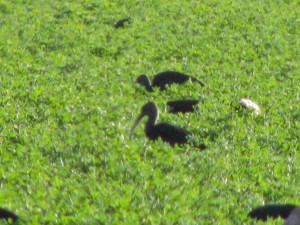
Ibis in agricultural fields. We were looking in particular for burrowing owls, and the advice we were puzzled to receive was to look in irrigation ditches and pipes along the road. Then, sure enough, as we were driving my daughter suddenly caught sight of one sitting alongside the road at the top of an irrigation ditch! He obligingly posed for many photographs. Later I saw two sitting at the opening of a pipe that protruded from an irrigation ditch! Amazing.

Burrowing owls nest in irrigation pipes One of the highlights for me was seeing sandhill cranes. These beautiful and majestic birds were feeding in ponds adjacent to flocks of pelicans. I didn’t happen to get any photos of them although my daughter did, because I was busy crawling under the car trying to find the source of the intense squealing sound that suddenly developed (only gravel in the wheel, thank goodness!) There were also hundreds of snow geese, and long strings of hundreds of red-winged blackbirds filled the sky as the sun set.

The only sound was the whisper of hundreds of blackbird wings overhead. We left, entranced, at sunset, and took the route home through the Anza-Borrego desert, up to 4,000 feet above sea level through the mountain town of Julian and back to Fallbrook in just over 2 1/2 hours. We covered about 275 miles that day, but it was well worth it for birding. The visitor’s center has many pamphlets on other birding areas in the vicinity, but they’d have to be done on other trips because there are just too many birds to see in one day!

The beautiful Gambel's quail Other birds we saw included Bonaparte’s gull, American Avocets, Stilt Sandpiper, Long-billed Dowitcher, and Gambel’s Quail, to name a few. An excellent birding site with Salton Sea bird list and locations is htttp://southwestbirders.com. Search for Salton Sea.
-
December in Fallbrook
Coots on the pond Sunlight in the sleeping willows. Tranquility (try not to look at the houses). Tough and determined roots being fed by decaying golden leaves. An impromptu Christmas tree: a snag decorated with juniper, cranberries and bird seed. Lush green weeds keeping a low profile in the winter. Stately sycamores; their leaves shed to keep their roots warm. A season of greens, golds and blues. Coyote bush seed fluff glowing white instead of snow. -
Becoming Very Behind in my Cleaning
